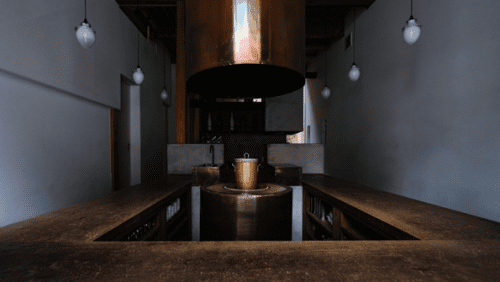 Yorozu, in Fukuoka, is an extraordinary place to drink tea and Suguru and Shinou will happily guide you in tasting and understanding green tea. The tea master has eight years of experience, and the CEO has twenty years of experience. They know their tea and the experience it deserves.
Yorozu, in Fukuoka, is an extraordinary place to drink tea and Suguru and Shinou will happily guide you in tasting and understanding green tea. The tea master has eight years of experience, and the CEO has twenty years of experience. They know their tea and the experience it deserves.
I mention green tea when discussing food in Japan because it usually accompanies food. However, fine tea on its own is an experience. So, we visited the Yorozu Bar in Fukuoka. This isn’t just any green tea, as the owner/ CEO explained. He started his interest in tea at 12 years old. The value of tea requires time, respect, and rest. Young people do not always follow Japanese culture, so he teaches kids to have an active interest in tea.
Japan tea culture.
It has been more than 1,200 years since tea was introduced to Japan. In Japan, it can be said tea is deeply rooted in people’s sense of beauty and the spiritual world. Based on the Japanese tea culture built over many years, they are working hard so that you can feel joy in sharing the present moment. They hope you will have a prosperous time in the modern tea space while enjoying it.
 What is green tea?
What is green tea?
All types of tea, even your regular cup of tea, are made from the camellia sinensis plant. Green tea comes from the emerald green colour created when brewing these unprocessed, unfermented leaves.
With origins dating back as 5,000 years, green tea is commonly drunk and grown in East Asia, where its health properties are highly valued. Green tea may have health benefits that you can access.
Warm and ambient temperatures are best to retain antioxidant compounds, so allow the boiled water to cool slightly before pouring over the tea leaves, and steep for between 2-3 minutes.
What Is Sencha?
Sencha is a steamed green tea made from small-leaf Camellia sinensis (tea bushes). Japanese sencha has a refreshing flavour described as vegetal, green, “seaweedy,” or “grassy.” Tastes vary with different types of sencha and how they are brewed.
Sencha is frequently consumed warm and at all day hours in Japan. With moderate to low levels of caffeine, it can provide a nice boost without keeping you up at night. It also makes a refreshing iced tea with a vibrant green colour and fresh flavour. It can be preferred to  coffee for some.
coffee for some.
We experienced Gyokuro tea, the highest quality green tea, and Hoji-cha, roasted green tea.
In our Yorozu experience, the temperatures for serving Gyokuro tea were as follows: First infusion: 35℃, Second infusion: 80℃, Third infusion: 90℃. Hojicha, roasted green tea, is steeped three times at 90℃.
For casual, at-home enjoyment, use a ratio of 1 teaspoon of tea to 1 cup of pure, fresh water (not distilled). Japanese sencha teas prefer a lower brewing temperature of around 170 F—if you don’t have a thermometer, use water that has just barely started to simmer. Sencha also requires a short brewing time. Some sencha’s are best with a 15- to 30-second steep, while others can handle up to 2 minutes. Whole-leaf tea bags are available. Follow the brewing instructions on the box. Enjoy! For more information, visit www.yorozu-tea.
Written by: Rick Coles
================================















